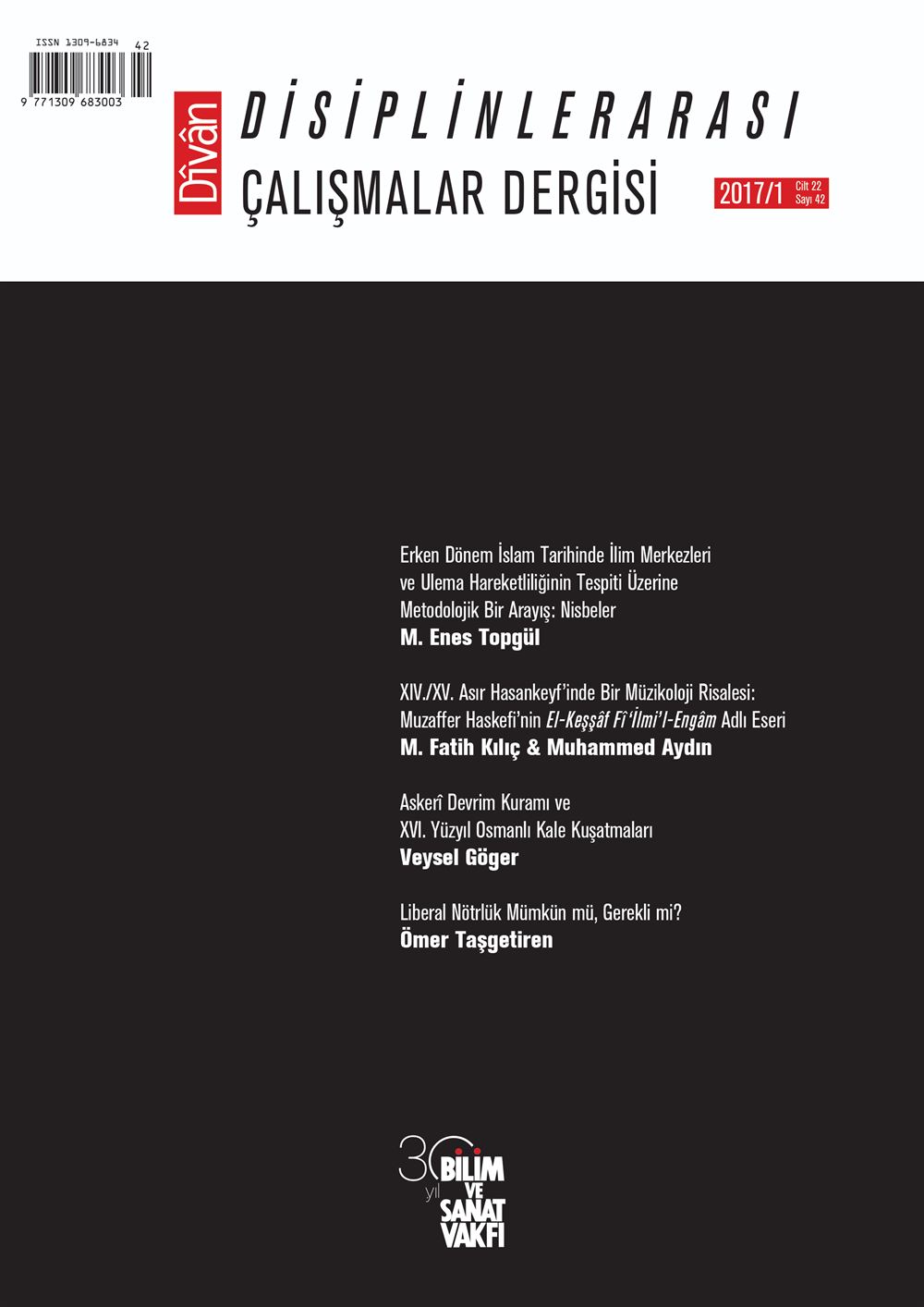42
Geride bıraktığı yirminci yıllık birikimiyle Dîvân, 42. sayısıyla okurlarını selamlıyor. Bu sayımızda İslam ilim tarihinden Askerî Devrim kuramına; siyaset teorisinden İslam müzik tarihine farklı alanları kapsayan dört makale ve güncel yazını takip eden yedi kitap değerlendirme yazısını ilgililerine sunuyoruz.
Articles
Determining the early centers of Islamic disciplines and the relations among them would fill many gaps within the history of Islamic scholarly disciplines in general and of hadith in particular. However, there is no widely accepted methodology for identifying these centers, the nature of scholarly journeys (rihlas), or the relationship between political actors and the rise of cities. Nor is there a consensus on the questions of what kinds of sources can serve as the basis for such inquiries and of how they can best be used. This article argues that centers of Islamic learning and rihla destinations can be determined through nisbas (attributive adjectives—adjectives denoting origin, profession, intellectual affiliations, etc.), which are recorded as standard information in tarikh, tabaqat and rijal works and may give information about a person’s familial, tribal, professional, and madhab affiliations. Utilizing isnad data, this article makes observations concerning early Sunni and Shi‘i centers of knowledge and rihla directions and destinations.
This article aims to explore the work al-Kashshaf fi Ilm al-Angham, written by Muzaffar al-Haskafi in fourteenth/fifteenth-century Hasankayf under the Ayyubids, and evaluate its place in the classical musicological literature. Al-Haskafi develops his ideas in relation with those of his predecessors and contemporaries, such as Safi al-Din al-Urmawi (d. 693/1294), Ibn Kurr (d. 759/1357), Shams al-Din al-Saydawi, and Jamal al-Din al-Mardini (d. 809/1406). Al-Haskafi does not write about the concept of rhythm, intervals, ratios between intervals, or concordant and dissonant intervals, which are among the fundamentals of a music theory. Al-Haskafi differs from his predecessors and contemporaries by using an ambiguous concept of bayt to explain the composition of the modes. He also gives examples of the melodic development of the modes. He devotes the last part of his work to the philosophy of music, and there offers a mystical account of music’s influence and affective power.
Muhammet Fatih KILIÇ Muhammed AydınCentered on military innovations and changes dating back well into the sixteenth century, Military Revolution Theory aims to elaborate the driving forces behind the West emerging as a rising power. Various scholars also use the theory to explain the decline and collapse of the Ottoman Empire. But the theory has been criticized on a number of fronts, including for its broad temporal scope and the degree of generalization it entails. This paper questions one of the theory’s main arguments specific to Ottoman society during the sixteenth century. According to the theory, the construction and spread of trace italienne (Italian-style) fortresses was a major development in period warfare, one that made sieges more difficult and protracted. The presence of such forces is thus used as a key criterion for determining whether a military revolution occurred in a certain region. This article disputes the validity of this criterion. By analyzing sixteenth-century Ottoman fortress sieges, it determines that the presence of trace italienne fortresses did not meaningfully affect siege durations in the period. These fortresses were not able to withstand a number of traditional Ottoman siege techniques, including constructing towers to fire over a fortress’s walls, undermining the walls themselves, and filling in a fortress’s defensive trenches. This study suggests that evaluating each fortress siege with due consideration to its own geopolitical conditions offers a better approach for assessing military advances in a given period.
Veysel GögerThis article introduces the major debates of the liberal neutrality literature in contemporary liberal political theory and critically evaluates the major claims of this literature. The article has the following main theses: First, the article contends that liberal theorists have failed to offer convincing arguments to justify why states should be neutral in the first place. Second, the article argues that liberal theorists make important exceptions in their neutrality theories and that these exceptions cast doubt on the validity of their theories. Third, the article draws attention to the problems that arise when a liberal state claims neutrality in articulating its aims and justifying its laws. Fourth, the article discusses whether a concept like “degrees of neutrality” would be a meaningful tool for comparing different states, and points out the problems of using such a terminology. Finally, the article contends that liberalism cannot legitimize its existence by referring to the concept of neutrality in a world characterized by value pluralism, and that liberalism will inevitably remain a sectarian doctrine. In general, the article draws attention to the exclusions and limitations of liberal states in dealing with diversity.
Ömer Taşgetiren





